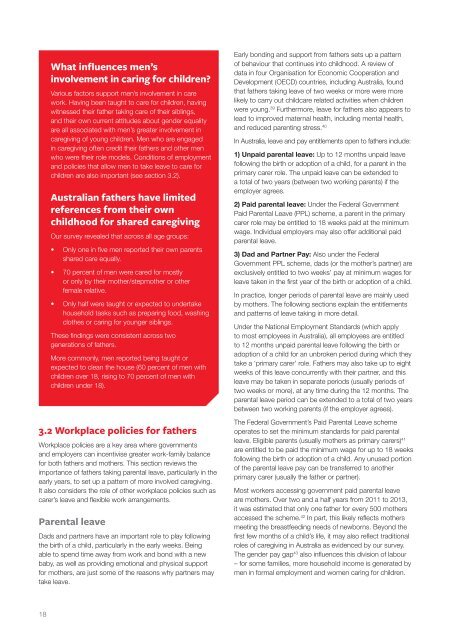State of Australia’s Fathers
1iGWp7w
1iGWp7w
- No tags were found...
You also want an ePaper? Increase the reach of your titles
YUMPU automatically turns print PDFs into web optimized ePapers that Google loves.
What influences men’s<br />
involvement in caring for children?<br />
Various factors support men’s involvement in care<br />
work. Having been taught to care for children, having<br />
witnessed their father taking care <strong>of</strong> their siblings,<br />
and their own current attitudes about gender equality<br />
are all associated with men’s greater involvement in<br />
caregiving <strong>of</strong> young children. Men who are engaged<br />
in caregiving <strong>of</strong>ten credit their fathers and other men<br />
who were their role models. Conditions <strong>of</strong> employment<br />
and policies that allow men to take leave to care for<br />
children are also important (see section 3.2).<br />
Australian fathers have limited<br />
references from their own<br />
childhood for shared caregiving<br />
Our survey revealed that across all age groups:<br />
• Only one in five men reported their own parents<br />
shared care equally.<br />
• 70 percent <strong>of</strong> men were cared for mostly<br />
or only by their mother/stepmother or other<br />
female relative.<br />
• Only half were taught or expected to undertake<br />
household tasks such as preparing food, washing<br />
clothes or caring for younger siblings.<br />
These findings were consistent across two<br />
generations <strong>of</strong> fathers.<br />
More commonly, men reported being taught or<br />
expected to clean the house (60 percent <strong>of</strong> men with<br />
children over 18, rising to 70 percent <strong>of</strong> men with<br />
children under 18).<br />
3.2 Workplace policies for fathers<br />
Workplace policies are a key area where governments<br />
and employers can incentivise greater work-family balance<br />
for both fathers and mothers. This section reviews the<br />
importance <strong>of</strong> fathers taking parental leave, particularly in the<br />
early years, to set up a pattern <strong>of</strong> more involved caregiving.<br />
It also considers the role <strong>of</strong> other workplace policies such as<br />
carer’s leave and flexible work arrangements.<br />
Parental leave<br />
Dads and partners have an important role to play following<br />
the birth <strong>of</strong> a child, particularly in the early weeks. Being<br />
able to spend time away from work and bond with a new<br />
baby, as well as providing emotional and physical support<br />
for mothers, are just some <strong>of</strong> the reasons why partners may<br />
take leave.<br />
Early bonding and support from fathers sets up a pattern<br />
<strong>of</strong> behaviour that continues into childhood. A review <strong>of</strong><br />
data in four Organisation for Economic Cooperation and<br />
Development (OECD) countries, including Australia, found<br />
that fathers taking leave <strong>of</strong> two weeks or more were more<br />
likely to carry out childcare related activities when children<br />
were young. 39 Furthermore, leave for fathers also appears to<br />
lead to improved maternal health, including mental health,<br />
and reduced parenting stress. 40<br />
In Australia, leave and pay entitlements open to fathers include:<br />
1) Unpaid parental leave: Up to 12 months unpaid leave<br />
following the birth or adoption <strong>of</strong> a child, for a parent in the<br />
primary carer role. The unpaid leave can be extended to<br />
a total <strong>of</strong> two years (between two working parents) if the<br />
employer agrees.<br />
2) Paid parental leave: Under the Federal Government<br />
Paid Parental Leave (PPL) scheme, a parent in the primary<br />
carer role may be entitled to 18 weeks paid at the minimum<br />
wage. Individual employers may also <strong>of</strong>fer additional paid<br />
parental leave.<br />
3) Dad and Partner Pay: Also under the Federal<br />
Government PPL scheme, dads (or the mother’s partner) are<br />
exclusively entitled to two weeks’ pay at minimum wages for<br />
leave taken in the first year <strong>of</strong> the birth or adoption <strong>of</strong> a child.<br />
In practice, longer periods <strong>of</strong> parental leave are mainly used<br />
by mothers. The following sections explain the entitlements<br />
and patterns <strong>of</strong> leave taking in more detail.<br />
Under the National Employment Standards (which apply<br />
to most employees in Australia), all employees are entitled<br />
to 12 months unpaid parental leave following the birth or<br />
adoption <strong>of</strong> a child for an unbroken period during which they<br />
take a ‘primary carer’ role. <strong>Fathers</strong> may also take up to eight<br />
weeks <strong>of</strong> this leave concurrently with their partner, and this<br />
leave may be taken in separate periods (usually periods <strong>of</strong><br />
two weeks or more), at any time during the 12 months. The<br />
parental leave period can be extended to a total <strong>of</strong> two years<br />
between two working parents (if the employer agrees).<br />
The Federal Government’s Paid Parental Leave scheme<br />
operates to set the minimum standards for paid parental<br />
leave. Eligible parents (usually mothers as primary carers) 41<br />
are entitled to be paid the minimum wage for up to 18 weeks<br />
following the birth or adoption <strong>of</strong> a child. Any unused portion<br />
<strong>of</strong> the parental leave pay can be transferred to another<br />
primary carer (usually the father or partner).<br />
Most workers accessing government paid parental leave<br />
are mothers. Over two and a half years from 2011 to 2013,<br />
it was estimated that only one father for every 500 mothers<br />
accessed the scheme. 42 In part, this likely reflects mothers<br />
meeting the breastfeeding needs <strong>of</strong> newborns. Beyond the<br />
first few months <strong>of</strong> a child’s life, it may also reflect traditional<br />
roles <strong>of</strong> caregiving in Australia as evidenced by our survey.<br />
The gender pay gap 43 also influences this division <strong>of</strong> labour<br />
– for some families, more household income is generated by<br />
men in formal employment and women caring for children.<br />
18


